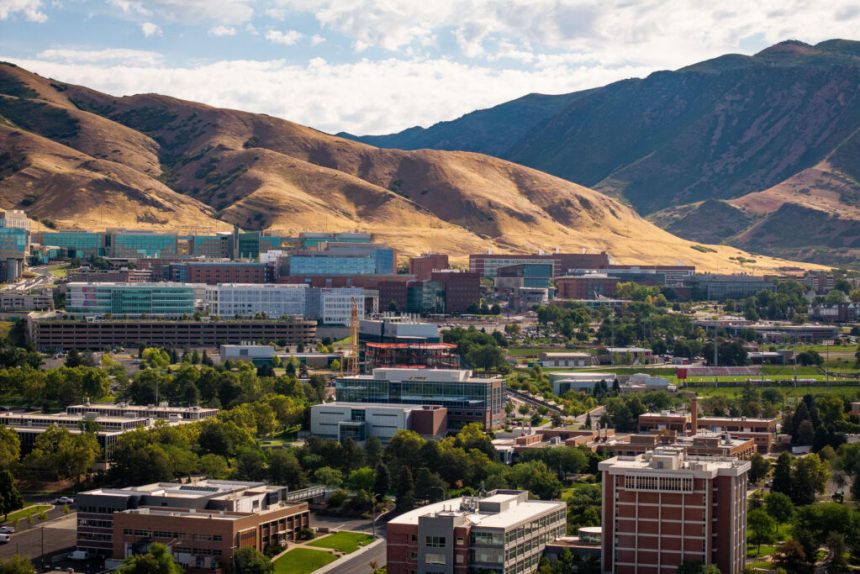The University of Utah campus in Salt Lake City is pictured on Saturday, Aug. 23, 2025. (Photo by Spenser Heaps for Utah News Dispatch)
To mark “10 years of impact,” the University of Utah’s Kem C. Gardner Policy Institute has issued a report highlighting key research on a wide range of Utah issues over the last decade.
The report commemorates the 10-year anniversary since the institute’s doors first opened in September 2015.
The man that the institute was named after — prominent business man and community leader Kem Gardner — said these words 10 years ago at an event celebrating its launch:
“I believe firmly that this policy institute can make life better for our state and for our children,” the Deseret News reported at the time.
SUBSCRIBE: GET THE MORNING HEADLINES DELIVERED TO YOUR INBOX
From data on the COVID-19 pandemic, to research on housing affordability and the shrinking Great Salt Lake, Kem C. Gardner researchers have “emerged as Utah’s premier source for economic, demographic, and public policy research that guides community leaders and helps policy makers” make informed decisions, the institute said in a news release announcing the report Thursday.
“Over the last 10 years, the Kem C. Gardner Policy Institute has proven to be indispensable to achieving the University of Utah’s goal of creating positive impact,” University of Utah President Taylor Randall said. “The Institute provides trusted data, rigorous analysis, and forums for sharing ideas, contributing significantly to our mission of generating unsurpassed societal impact.”
The 10-year report includes key findings on some of the biggest issues that Utah has — and continues — to face. They include:
-
Data and analysis during the COVID-19 pandemic
-
Long-term economic and demographic projections informing the state’s population growth and resulting changes.
-
Challenges with housing affordability and how Utah compares to other states.
-
Economic impacts of the 2034 Olympics and how Utah must prepare.
-
Research on the adverse effects of the shrinking Great Salt Lake and data to inform water management decisions.
While it highlights past research, the report also looks ahead. It lists seven reasons — what researchers described as the “magnificent seven” — that make up a “constellation of economic achievements that sets it apart from the rest of the nation.”
Those include, according to the report, economic diversity, high household income and low poverty, high upward mobility opportunities, a “relatively equal distribution of income,” a well-trained and educated workforce, a fast-growing and young population, and high levels of social capital and strong community bonds.
Researchers, however, also listed what they called “Utah’s troubling seven,” or challenges that could spell trouble if they go unaddressed.
They included:
-
Housing affordability and homelessness: “Utah’s housing market has become increasingly unaffordable, leading to a rise in homelessness and limiting access to homeownership for many,” researchers wrote. With a median sales price of a single-family home hitting more than $548,000 in the fourth quarter of 2024, Utah ranked as the ninth most expensive housing market in the U.S., according to the report.
-
Traffic congestion: The state’s growing population has “strained Utah’s transportation infrastructure,” the report says, “resulting in significant traffic congestion and reduced quality of life.”
-
Public education: A “concerning number” of Utah third graders are not proficient in reading, researchers wrote, with only 46.7% of Utah third graders scoring proficiently on the RISE test, a state-mandated standardized test.
-
Higher education: Compared to other states, Utah’s college and university enrollment and graduation rates lag behind other states, “limiting the potential of its workforce and economy,” the report says.
-
Great Salt Lake: The lake’s declining water levels continue to “pose significant environmental, economic and health risks to the state,” researchers warned.
-
Energy supply: Due to growing energy demand, constraints on supply and the need to transition to cleaner energy sources, Utah “faces potential energy deficits,” the report says.
-
Behavioral health: Like the rest of the nation, Utah is seeing a “growing behavioral health crisis, requiring a greater access to mental health and substance abuse services,” researchers wrote.
To address those issues, researchers also listed the “starting seven,” or ideas to “serve as a conservation starter for a statewide dialogue” on the state’s biggest challenges.
-
For housing affordability, they recommended the creation of a “statewide community land trust.”
-
For traffic congestion, they urged prioritization of “connected autonomous vehicles.”
-
To increase third grade reading proficiency, they encouraged education leaders to “place a reading pro in K-3 classrooms.”
-
To improve higher education graduation rates, they recommended the expansion of “catalyst centers” into Salt Lake City.
-
For the Great Salt Lake, they recommended the conservation of 250 kilometer acre feet (KAF) to 500 KAF each year. The KAF measurement refers to a thousand acre-foot, or a unit of volume representing 1,000 acre-feet of water. It’s commonly used to measure water in reservoirs, rivers or snow pack.
-
For energy, they encouraged investment in the state energy research fund.
-
For behavioral health, they said to “align behavioral health efforts and investments with Utah’s strategic plan.”









